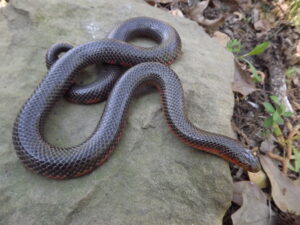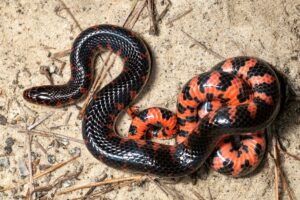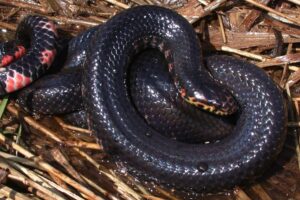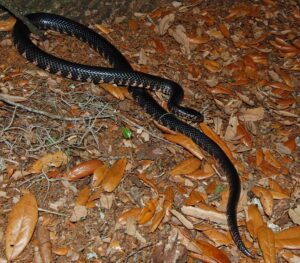The mud snake or red-bellied mud snake is a large, thick-bodied, mostly aquatic, nocturnal colubrid native to the southeastern United States. In local folklore, it is sometimes referred to as the hoop snake that takes its tail in its mouth and rolls downhill, its body circled in a vertical loop to chase down people. But it is a myth, and mud snakes lack this capability.
Scientific Classifications
- Suborder:Serpentes
- Family:Colubridae
- Genus:Farancia
- Species:F. abacura
Conservation Status
Subspecies
This snake has two recognized subspecies.
- Eastern mud snake (Farancia abacura abacura)
- Western mud snake (Farancia abacura reinwardtii)
Description

Size
The total length attained by the snake is 40-54 in (1-1.4 m). The maximum recorded size for the species is slightly over 80 in (2 m), and the females are larger than the males in total length.
Color and Appearance
The dorsal side of the mud snake is glossy black, while the ventral side is red and black, with the red extending up the sides to form reddish-pink bars. However, some have entirely black bodies with slightly lighter black spots instead of the standard reddish colors. The heavy body has a cylindrical cross-section, and the short tail ends in a spine.
The head scalation is unique as there is only a single internasal scale, a single anterior temporal scale, and no preocular scale. The smooth dorsal scales are arranged in 19 rows at the midbody. There are 31-55 subcaudal scales and 168-208 ventral scales. The snake has a divided anal plate.
Are They Dangerous to Humans
When mud snakes are disturbed, they tuck their heads under their coils and expose the red undersides of their tails to warn their attacker. When captured, the secretive snake rarely bites but can lightly stick the captor with the tail spine, which is harmless.
Mud Snakes at a Glance
Distribution
The mud snake inhabits the states of Arkansas, Alabama, Florida, Illinois, Georgia, Kentucky, Mississippi, Missouri, Louisiana, North Carolina, South Carolina, Oklahoma, Texas, Tennessee, and Virginia.
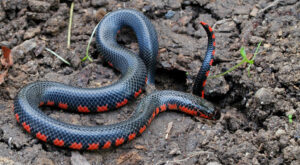
Habitat
It lives in cypress swamps and the edges of streams, below ground debris, and among dense vegetation. It uses wet conditions to bury itself in the mud. Hence its common name.
The colubrid is almost fully aquatic as it rarely leaves the water except to hibernate, lay eggs, and escape drying wetlands during a drought. It occupies aquatic habitats with brackish water or freshwater.
Lifespan
Their lifespan in the wild is unknown. Their maximum recorded lifespan in captivity is 19 years.
Predators
Its predators are herons, skunks, raccoons, American alligators, and cottonmouths.
Diet
Its food mainly consists of giant aquatic salamanders in the Amphiuma and Siren genera. But the mud snake also eats other amphibians. It uses its sharply pointed tail to prod its prey earning it the nickname ‘stinging snake’. But its tail is not a stinger and can’t sting. The enlarged teeth at the rear of its upper jaw presumably help to hold on to slippery prey.
Reproduction
Oviparous (lays eggs that hatch outside the body)
Mud snakes breed in spring, mainly in April and May. 8 weeks post-mating, a female lays a clutch of 4-111 eggs in a nest built of moist soil and, sometimes, alligator nests. The clutch size increases with the snake’s length, with the bigger females having larger clutch sizes. She remains with her eggs till they hatch in the fall, usually in September or October.
It is thought that the hatchlings either enter aquatic habitats in the autumn or delay doing so till spring, but it is yet to be known if they disperse into terrestrial habitats or remain in a terrestrial nest during the intermediate time.
Source
inaturalist.ca, a-z-animals.com, scparc.org, calphotos.berkeley.edu, herpsofnc.org, floridabackyardsnakes.com

